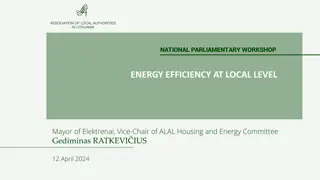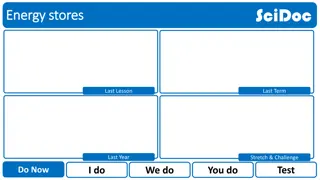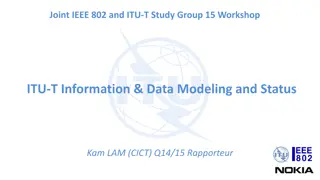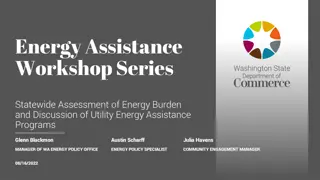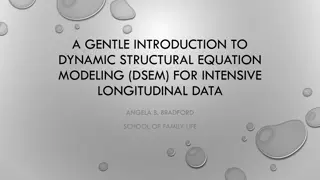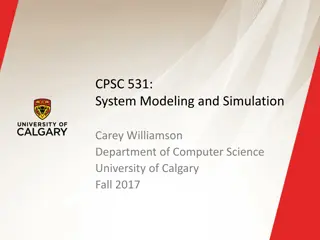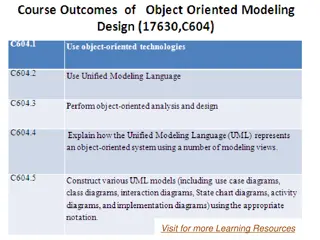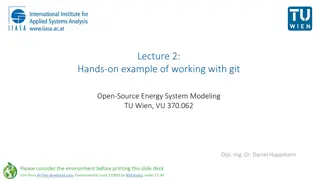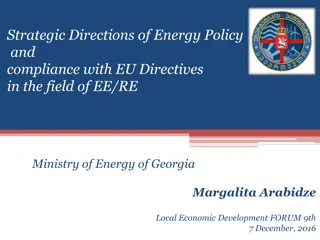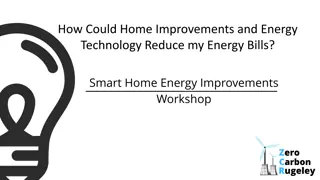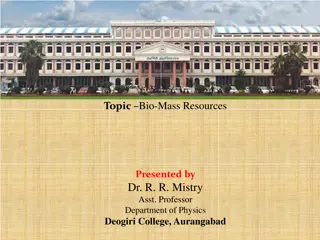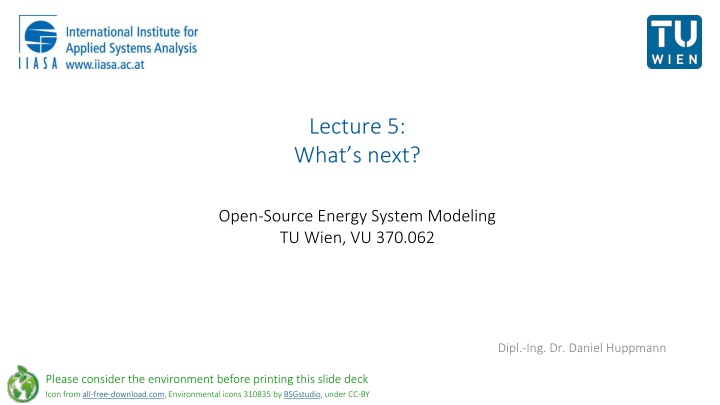
Open-Source Energy System Modeling at TU Wien
This presentation explores the advantages and challenges of open-source energy system modeling, highlighting the low barriers to entry and democratization of research it offers. It discusses practical considerations for setting system boundaries, delves into the scenario space of Shared Socioeconomic Pathways, and explains the pathway development process through individual storylines. Dr. Daniel Huppmann from TU Wien leads this insightful lecture, emphasizing the importance of conscious choices in energy system modeling.
Uploaded on | 0 Views
Download Presentation

Please find below an Image/Link to download the presentation.
The content on the website is provided AS IS for your information and personal use only. It may not be sold, licensed, or shared on other websites without obtaining consent from the author. If you encounter any issues during the download, it is possible that the publisher has removed the file from their server.
You are allowed to download the files provided on this website for personal or commercial use, subject to the condition that they are used lawfully. All files are the property of their respective owners.
The content on the website is provided AS IS for your information and personal use only. It may not be sold, licensed, or shared on other websites without obtaining consent from the author.
E N D
Presentation Transcript
Lecture 5: What s next? Open-Source Energy System Modeling TU Wien, VU 370.062 Dipl.-Ing. Dr. Daniel Huppmann Please consider the environment before printing this slide deck Icon from all-free-download.com, Environmental icons 310835 by BSGstudio, under CC-BY all-free-download.com BSGstudio
Part 1 Open-source energy system modelling boon or bane? Open-Source Energy System Modeling, Lecture 5 Daniel Huppmann 2
Open-source lowers barriers to entry for energy-system++ modelling The barriers to energy system modelling are almost zero. Is that a good thing? Required ingredients to energy system modelling Cheap computing power to run large-scale assessments Open-source tools for data processing, model execution, and results analysis Publicly available data sets Free lecture material, online courses, etc. E.g.: Youtube channel Teaching Energy Modelling OSeMOSYS Teaching Kit The barriers to start model development are virtually zero Advantage: democratization of research Disadvantage: risk of doing subpar research (herd behaviour, quick-and-dirty analysis) The academic incentive structure is misaligned towards novelty rather than collaborative work Open-Source Energy System Modeling, Lecture 5 Daniel Huppmann 3
Some practical considerations for starting model development Make a conscious choice concerning the system boundaries of your work Earth system Biosphere Ecosystem (services) Climate system Forestry Fossil resources Renewables Oceans Land use Economy Extraction & Mining Water Transformation Agriculture Electricity sector Air quality Human needs Demand Sector Food Demand Health & Poverty Mobility, Lighting, Heating/Cooling, ... Energy system Open-Source Energy System Modeling, Lecture 5 Daniel Huppmann 4
The scenario space of the Shared Socioeconomic Pathways In contrast to earlier model family set-ups and scenario design processes, the SSP s started from challenges along the adaption vs. mitigation dimension Schematic illustration of main steps in developing the SSPs, Fig. 1, O Neill et al. (2017) Lecture 7 - International Affairs: Power & Technology September 27, 2017 5
The pathway development process Starting from individual storylines and a number of drivers, the energy system projections for each pathway were developed Schematic illustration of main steps in developing the SSPs , Fig. 1, Riahi et al. (2017) Lecture 7 - International Affairs: Power & Technology September 27, 2017 6
More practical considerations for starting model development Choose an appropriate methodology for the research question at hand Commonly used methodologies: Optimization: determine the system that is optimal according to a metric Equilibrium: determine the system as a result of interacting agents Simulation: determine the system given some decision rules Dealing with uncertainty: Deterministic optimization (perfect foresight): all future states (exogenous parameters) are known at the beginning of the model horizon Stochastic optimization: all future states along an uncertainty tree are known, including probabilities of each branch Myopic (rolling horizon) optimization: decisions in period y are taken under some assumptions about the future; move to period y + 1 and repeat, with (possibly altered) assumptions about periods [y + 2, ... ] Open-Source Energy System Modeling, Lecture 5 Daniel Huppmann 7
Yet more practical considerations for starting model development There are many issues that a self-critical modeller should consider... Model uncertainty: Is the approach appropriate? Are results dependent on the methodology? Parameter uncertainty: How much confidence can you have on input assumptions? Model horizon and level of temporal/spatial disaggregation: What is the intended scope of analysis? Beware of the end-of-horizon -effect! Model simplifications for numerical tractability and comprehensibility: What are appropriate trade-offs between having a high level of detail vs. loosing focus? E.g., variable renewables require infrastructure for system stability assumption or result? System boundaries and model closure: Are the assumptions to close the model valid? E.g., for a national electricity model, you need to make assumptions about import/export Open-Source Energy System Modeling, Lecture 5 Daniel Huppmann 8
Methods to evaluate the robustness of results Think hard about testing your model behaviour Methods for validation: Sensitivity analysis: Structured variation of key input parameters to understand the impact on results Relatively easy to do, but you can never do sensitivity assessment for all parameters... Multi-criteria analysis: Include multiple dimensions in the objective function, solve model with different weights Requires some work, still prone to modelling artefacts Modelling to generate alternatives Re-solve a model to get a different solution within some additional bounds Very elegant, but requires substantial effort to implement Further reading: Joseph F. DeCarolis. Using modeling to generate alternatives (MGA) to expand our thinking on energy futures. Energy Economics 33(2):145-152, 2011. doi: 10.1016/j.eneco.2010.05.002 Open-Source Energy System Modeling, Lecture 5 Daniel Huppmann 9
Part 2 So you have some results... How can you present them to maximize impact? A few comments on better-practice for communication of insights Open-Source Energy System Modeling, Lecture 5 Daniel Huppmann 10
The importance of framing for good science communication Scientists (engineers in particular) tend to frown upon framing Economists believe in the invisible hand of efficient markets They too often ignore the key assumption of full information in markets Engineers are confident that they have the right answer and hope that science will prevail Social scientists and marketing executives understand the importance of communication They understand the role of appropriate words, intuitive visuals, appealing to emotions, etc. Framing is not about distorting the message! It means ensuring that message & messaging are aligned and reflect the same values! Possible entrypoints: George Lakoff, Professor Emeritus at the University of California, Berkeley https://framelab.us (check out their podcast) Podcast Petajoule by the Austrian Energy Agency (in German) Open-Source Energy System Modeling, Lecture 5 Daniel Huppmann 11
An example for great framing: More than showing ranges of scenarios The arrows indicate that more (ambition) means less (GHG emissions) and they illustrate how various levels of ambitions build on each other Figure 1 | Global greenhouse gas emissions as implied by INDCs compared to no-policy baseline, current-policy and 2 C scenarios. Joeri Rogelj et al. (2016) Paris Agreement climate proposals need a boost to keep warming well below 2 C. Nature 534:631, 2016. doi: 10.1038/nature18307 Open-Source Energy System Modeling, Lecture 5 Daniel Huppmann 12
Visualizing beyond the data: include icons and other elements in figures The key messages of this commentary are the process as much as the data, so it s ok to include an appealing visual representation to highlight this aspect Figure 1 | Overview of process of compilation of scenario ensemble data and illustrative data visualizations. D. Huppmann et al. (2018). A new scenario resource for integrated 1.5 C research. Nature Climate Change, 8:1027-1030. doi: 10.1038/s41558-018-0317-4 Open-Source Energy System Modeling, Lecture 5 Daniel Huppmann 13
Better communication of research: Designing more appealing posters Scientists feel pressured to put all their knowledge in a manuscript/onto a poster, but creating a wall of text is not a good approach to communicate your work Check out the full video for #betterposters at https://www.youtube.com/watch?v=1RwJbhkCA58 Open-Source Energy System Modeling, Lecture 5 Daniel Huppmann 14
A short clip on how to improve data table visualization via Twitter from @jessicadjewell https://t.co/gE0qnRxBLK Open-Source Energy System Modeling, Lecture 5 Daniel Huppmann 15
Thank you very much for your attention! Dr. Daniel Huppmann Research Scholar Energy Program International Institute for Applied Systems Analysis (IIASA) Schlossplatz 1, A-2361 Laxenburg, Austria huppmann@iiasa.ac.at huppmann@iiasa.ac.at http://www.iiasa.ac.at/staff/huppmann http://www.iiasa.ac.at/staff/huppmann This presentation is licensed under Creative Commons Attribution 4.0 International License a Creative Commons Attribution 4.0 International License






